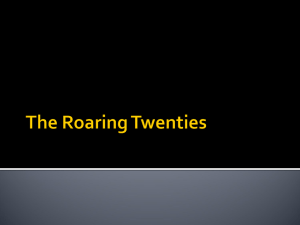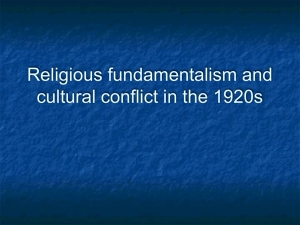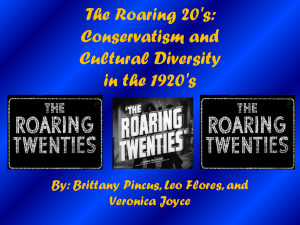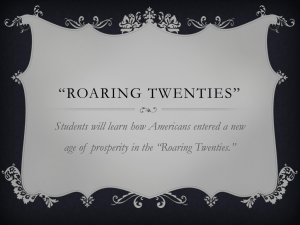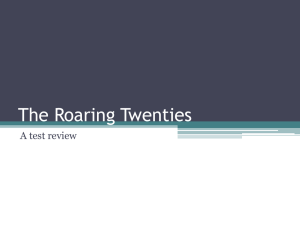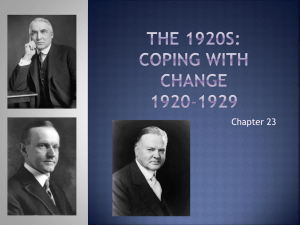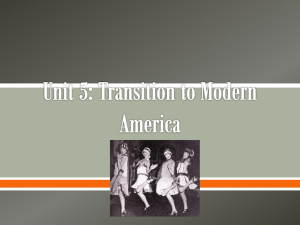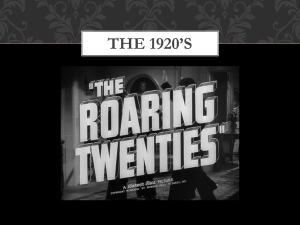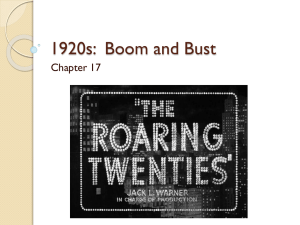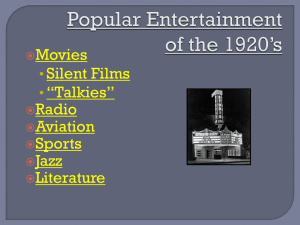1920s
advertisement
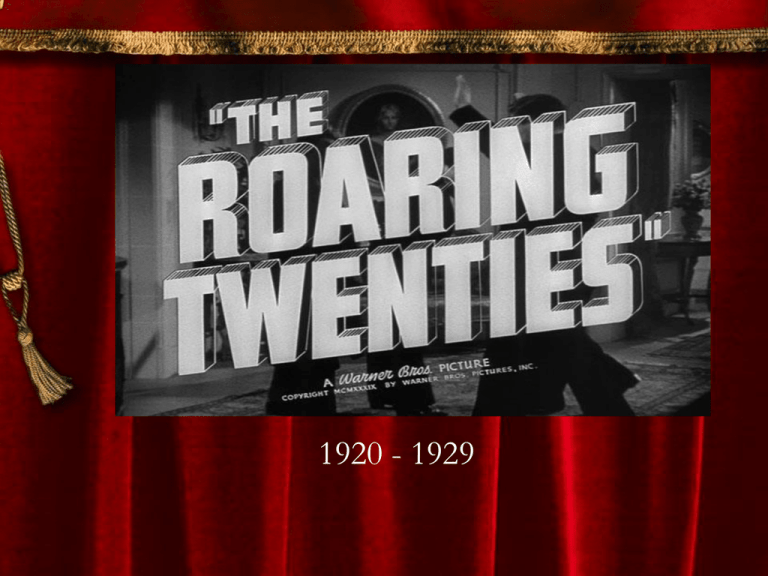
1920 - 1929 Major Themes • • • • • • • • Second industrial revolution transforms economy The promise (and limits) of prosperity in the 1920s New mass media and culture emerges Republican Party dominates Political and cultural trends Rise and fall of KKK Immigration Issues Role of Evolution Warren G (Harding) • Won the election of 1920 on a slogan: “A return to normalcy” • Republican- (Wilson was only Democratic President between 1892 and 1932- FDR) • People had grown tired of Wilson international entanglements and domestic policy • Normalcy, under the Harding administration, meant a government that was pro-business, anti-tax, and antiregulation. • Harding's Treasury Secretary, financier Andrew Mellon, cut income tax rates for the wealthiest Americans from 73% to 25%. The Second Industrial Revolution • Due to technology, manufacturing was able to increase the industrial output without expanding the workforce • Electricity replaces steam as main source • Factories became more reliant on mass produced items (Assembly Line) • Construction expanded, especially homes since back log from WW I The Modern Corporation • 1920s marked the emergence of the Modern Corporation • Shift control from away from owners of corporate stocks to everyday business leaders (CFO) • Examples: Alfred Sloan @ GM and Owen Young @ Radio Corporation • Emergence of salary executives, managers, & engineers ran companies without having stick themselves • Corporations were in THREE main areas: Integration of production and distribution, product diversification, and industrial research • By 1929, the 200 largest corporations had nearly ½ nation’s wealth. Oligopolies became the norm Welfare Capitalism • Favor shown unions during WWI worried corporations • Corporations worked to improve worker well-being and morale in what became known as Welfare Capitalism to prevent more workers from complaining or going to Unions (Examples: Insurance, Savings, Homes, etc.) • Despite these attempts, common complaints remained: seasonal unemployment, low wages, long hours, and unhealthy factory conditions • Open Shops- To combat unions, many companies made it so workers did NOT have to join unions to get benefits. It was thought less people would join and pay dues, and eventually the unions would fail Unions Lose Ground • Open shop cut gains made in a union shop (where new employees had to join an existing unions) or closed shops- where companies only hired union workers • 1920s- Union membership declined ( 5million in ‘20 to 3.5 million in ‘26) • William Green (replaced Gompers of the AFL) did not seek to incorporate workers in mass production fields into union. • Government revert back to pro-business and Supreme Court consisting upholding injunctions to prevent strikes, picketing, and other union activities Knights of Labor of America Preamble • • • • • TO THE PUBLIC: The alarming development and aggressiveness of great capitalists and corporations, unless checked, will inevitably lead to the pauperization and hopeless degradation of the toiling masses. It is imperative, if we desire to enjoy the full blessings of life, that a check be placed upon unjust accumulation, and the power for evil of aggregated wealth. This much-desired object can be accomplished only by the united efforts of those who obey the divine injunction, "In the sweat of they face shalt thou eat bread." Therefore we have formed the Order of Knights of Labor, for the purpose of organizing and directing the power of the industrial masses, not as a political party, for it is more in it are crystallized sentiments and measures for the benefit of the whole people, but it should be borne in mind, when exercising the right of suffrage, that most of the objects herein set forth can only be obtained through legislation, and that it is the duty of all to assist in nominating and supporting with their votes only such candidates as will pledge their support to those measures, regardless of party. But no one shall, however, be compelled to vote with the majority, and calling upon all who believe in securing "the greatest good to the greatest number," to join and assist us, we declare to the world that are our aims are: • • • • • • • • • • • • • • • • • • • • • • • • • To make individual and moral worth, not wealth, the true standard of individual and National greatness. To secure to the workers the full enjoyment of the wealth they create, sufficient leisure in which to develop their intellectual, moral, and social faculties: all of the benefits, recreation and pleasures of association; in a word, to enable them to share in the gains and honors of advancing civilization. In order to secure these results, we demand at the hands of the State: The establishment of Bureaus of Labor Statistics, that we may arrive at a correct knowledge of the educational, moral and financial condition of the laboring masses. That the public lands, the heritage of the people, be reserved for actual settlers; not another acre for railroads or speculators, and that all lands now held for speculative purposes be taxed to their full value. The abrogation of all laws that do not bear equally upon capital and labor, and the removal of unjust technicalities, delays and discriminations in the administration of justice. The adoption of measures providing for the health and safety of those engaged in mining and manufacturing, building industries, and for indemnification to those engaged therein for injuries received through lack of necessary safeguards. The recognition, by incorporation, of trades' unions, orders and such other associations as may be organized by the working masses to improve their condition and protect their rights. The enactment of laws to compel corporations to pay their employees weekly, in lawful money, for the labor of the preceding week, and giving mechanics and laborers a first lien upon the product of their labor to the extend of their full wages. The abolition of the contract system on National, State and Municipal works. The enactment of laws providing for arbitration between employers and employed, and to enforce the decision of the arbitrators. The prohibition by law of the employment of children under 15 years of age in workshops, mines and factories. To prohibit the hiring out of convict labor. That a graduated income tax be levied. And we demand at the hands of Congress: The establishment of a National monetary system, in which a circulating medium in necessary quantity shall issue direct to the people, without the intervention of banks; that all the National issue shall be full legal tender in payment of all debts, public and private; and that the Government shall not guarantee or recognize any private banks, or create any banking corporations. That interest-bearing bonds, bills of credit or notes shall never be issued by the Government, but that, when need arises, the emergency shall be met by issue of legal tender, non-interest-bearing money. That the importation of foreign labor under contract be prohibited. That, in connection wit the post-office, the Government shall organize financial exchanges, safe deposits and facilities for deposit of the savings of the people in small sums. That the Government shall obtain possession, by purchase, under the right of eminent domain, of all telegraphs, telephones and railroads, and that hereafter no charter or license be issued to any corporation for construction or operation of any means of transporting intelligence, passengers or freight. And while making the foregoing demands upon the State and National Government, we will endeavor to associate our own labors. To establish co-operative institutions such as will tend to supersede the wage system, by the introduction of a co-operative industrial system. To secure for both sexes equal pay for equal work. To shorten the hours of labor by a general refusal to work for more than eight hours. To persuade employers to agree to arbitrate all differences which may arise between them and their employees, in order that the bonds of sympathy between them may be strengthened and that strikes may be rendered unnecessary. American Federation of Labor Declaration of Principles • “Whereas a struggle is going on in the nations of the civilized world, between the oppressors and oppressed of all countries, a struggle between capital and labor which must grow in intensity from year to year and work disastrous results to the toiling millions of all nations, if not combined for mutual protection and benefits. The history of the wage workers of all countries is but the history of constant struggle and misery, engendered by ignorance and disunion, whereas the history of the non-producers of all countries proves that a minority thoroughly organized may work wonders for good or evil. It behooves the representatives of the workers of North America in congress assembled, to adopt such measures and disseminate such principles among the people of our country as will unite them for all time to come, to secure the recognition of the rights to which they are justly entitled. The various trades have been affected by the introduction of machinery, the subdivision of labor, the use of women's and children's labor and the lack of an apprentice system, so that the skilled trades are rapidly sinking to the level of pauper labor. To protect the skilled labor of America from being reduced to beggary and to sustain the standard of American workmanship and skill, the trades unions of America have been established.” • • • • • • • • • Preamble to the Constitution of the IWW The working class and the employing class have nothing in common. There can be no peace so long as hunger and want are found among millions of the working people and the few, who make up the employing class, have all the good things of life. Between these two classes a struggle must go on until the workers of the world organize as a class, take possession of the means of production, abolish the wage system, and live in harmony with the Earth. We find that the centering of the management of industries into fewer and fewer hands makes the trade unions unable to cope with the ever growing power of the employing class. The trade unions foster a state of affairs which allows one set of workers to be pitted against another set of workers in the same industry, thereby helping defeat one another in wage wars. Moreover, the trade unions aid the employing class to mislead the workers into the belief that the working class have interests in common with their employers. These conditions can be changed and the interest of the working class upheld only by an organization formed in such a way that all its members in any one industry, or in all industries if necessary, cease work whenever a strike or lockout is on in any department thereof, thus making an injury to one an injury to all. Instead of the conservative motto, "A fair day's wage for a fair day's work," we must inscribe on our banner the revolutionary watchword, "Abolition of the wage system." It is the historic mission of the working class to do away with capitalism. The army of production must be organized, not only for everyday struggle with capitalists, but also to carry on production when capitalism shall have been overthrown. By organizing industrially we are forming the structure of the new society within the shell of the old. Vroom Vroom Beep Beep: The Auto Age The Auto Age • “Roaring” Twenties • Arguably (actually, little arguing), the automobile HAD THE GREATEST IMPACT on the lives of Americans of the 1920s (and probably of all time) • 1920s- U.S. made 85% of all the world’s cars Henry Ford • Pioneer to the industry • Mastered (didn’t invent) ASSEMBLY LINE • Paid workers $5/8 hr workday (double the going rate) and forbade union membership • 2/3 of his workers were immigrants (Eastern & Southern Europe) and employed 5,000 African Americans- more than any other large American company General Motors • By 1927- Ford had sold 15 million MODEL T (“You can have it in any color as long as its black”), but was facing tough competition from GM • GM had divided line: Cadillac= Wealthy, Chevrolet= Least Expensive • Business structure became model for other businesses Auto Boom • Autos provided a boom in other areas: – – – – – – – Steel Rubber Gas / Oil Suburbs Motels Billboards Diners Cities and the ‘Burbs • 1920 Census - Urban population was bigger than rural for 1st time in US History • Cities promised more jobs, cultural richness, and personal freedoms • Suburbs- Grew at twice the rate of their core cities – Real Estate- Grosse Point (Detroit) & Elmwood Park (Chicago) grew 700% in 10 years – Car suburbs were less dense than suburbs along mass transit NOT ALL Benefitted: The Farmers • • • • 1920s: ¼ of US population were in agriculture 1914-19: Golden Age for farmers: WHY? WW I- Feed our troops and Europe suffering To cash in, more crops were planted >> Worldwide Surplus >> Lower Prices (both crops and land) >> Economic Hardship >> FARMERS WILL HIT DEPRESSION FIRST The King is Back • Cotton prices dropped (1920- $.37/lb Mid 1920- $.14/lb) so planted more and became more dependant • South’s inability (refusal) to diversify crops continued the downward trend and put it further behind • Hog and cattle prices also fell • Summary: Green Acres is AIN’T the place, Farm livin is for fools • SILVER LINING: Textile Industry Consolidated and Shifted: Textile manufacturers in New England (Lowell Mills) shifted to Piedmont Area of North and South Carolina because women clothing used less fabric and competition from other fibers (rayon) meant manufacturers wanted closer to source McNary-Haugen Bills • Series of complicated bills that attempted to fix the problems • Borrowed from the old Populist ideas: Government would buy surplus and either store them or sell on world market • The result was suppose to be a higher domestic prices • Calvin Coolidge (President #30) Vetoed Coal Miners and Railroad • Other sectors of the economy failed to benefit • Coal Miners as gas (oil based products) became more important • Once mighty and great RAILROAD industry slowed as the result of cars New Mass Culture • “Roaring” Twenties: Captures explosion of images and sound • Movies and radios exploded in popularity which led to advertising boom= Shift from what we needed to what we wanted • Movies moved from silent (Example: “Birth of a Nation (1915)” by D.W. Griffith )to “Talkies” such as “The Jazz Singer” (1927) • Newspapers will also consolidate: Hearst & Gannett were two major ones Mass Media and the Jazz Age • The founding of Hollywood – Drew film makers to the area in 1900. – Variety of landscapes (mountains, desert, ocean) – Warm climate – Lighting was better – Large work force from LA. Advertising • A thriving advertising industry both reflected and encouraged the growing importance of consumer goods in American life • Committee on Public Information from WW I helped to make advertisers appear to be “better” and more “trustworthy” • Market research began to be used • Household names: Kleenex Phonograph and Radio • Radios begin to give Americans a “common experience” • Increased success of ads • Phonograph now used better records Sports and Celebrity • Professional sports experienced a boom in the 1920s – “Black Sox” Scandal in 1920 – George Herman “Babe” Ruth: 1914-35 • Added again by newspapers, radios, magazines, and newsreels- Again a common experience • Movie stars, radio personalities, musicians, and athletes became the new elite Charles Lindberg • Became an American Hero • First person to fly solo across the Atlantic Ocean • May 20-21, 1927 • Was aboard The Spirit of St. Louis • Will later lose prestige because of his Nazi sympathizing • Son will be kidnapped & killed Amelia Earhart • 1928 – first woman to cross the Atlantic in a plane. • 1932 – first woman to fly solo across the Atlantic. • First to fly from Hawaii to California. • Professor at Purdue • Disappeared in 1937 while attempting to be first circumnavigate world A New Morality: The Flapper • A 1920s term used to describe a new type of young womanrebellious, energetic, fun-loving, and bold often with bobbed hair • Women started to do “un-lady like” activities- For example- drinking alcohol and smoking • Dress more provocatively • Despite the “Flapper” being associated to the 1920s, was not as commonplace as is often thought • Activities such as sensuality, sexual experimentation (including homosexuality), drinking, heavy make-up was already there in subcultures, but will start making it slowly into more middle class mainstream • Margaret Sanger- Continued campaign for birth control and did so vigorously through the 1920s Resistance to Modernity • A large percentage of Americans still resisted the cultural changes that were occurring throughout the U.S. but especially the cities • Deep and persistent tensions continued in terms of ethnic, racial, and geographical overtones dominated the politics • Red Scare increased anti-radicalism (which will also hurt Unions) Resistance to Modernity: Prohibition • 18th Amendment: Prohibition: Outlawed the manufacture and sell of alcohol and took effect in Jan. 1920 • Women’s Christian Temperance Movement • Part of a long campaigned that connect alcohol with the degradation of working class families and the worst evils of urban politics • Volstead Act of 1919: Was designed to help enforce Prohibition, but overwhelmed Bootleggers and Speakeasies • Bootleggers: Those that illegal transported alcoholic beverages • Speakeasies: Secret taverns and bars that served alcohol during the prohibition (often time they would front as legit businesses) Organized Crime • The profits available from bootlegging was astronomical compared to previous “organized crime” favorites: Gambling, Prostitution, and Robbery • Organized Crime followed similar model that corporations had: Smaller operations gave way to larger and more complex operations. AL “Scarface” Capone – – – – Chicago / Hideout in French Lick St. Valentine’s Day Massacre Arrested for tax invasion Died in prison due to complications of syphilis Some of the Other Famous Gangsters • John Dillinger • Lester “Baby Face Nelson” Gills • Bonnie and Clyde • Pretty Boy Floyd Prohibition Also Gave US: Immigration • Sentiments to restrict immigration had been growing since the late 1800s, but reached a peak immediately after WW I • One reason: The “new immigrant” were mostly Catholic and Jewish, darker skinned than “old immigrants”: To Americans they also seemed less willing to ASSIMILATE • Look at Chart on Page 819 • Immigration Act of 1921- Setting a maximum number of immigrants at 357,000 and quotas to limit from any one European county at 3% of their population in the U.S. 1910 Census • Johnson-Reed Immigration Act of 1924: Revised quota to 2% of 1890 Census levels and limited overall 164,000, and eliminated those that can’t be citizens- East and South Asia • Ozawa v. U.S. (1922) and U.S. v. Thind (1923)- Supreme Court ruled that Japanese & Asian Indians were inassimilable and racially ineligible for citizenship in the US • • • • • • The KKK Immigration issues were brought up by a resurgent natives movement, and the KKK was the most effective at spreading this message Had died out in the 1870s due to the Civil Rights Act of 1871, but remerged in GA largely in part because of D.W. Griffith’s “Birth of a Nation” Remerged as a “defender of traditional values of small-town Protestant America” Hiram W. Evans- became Imperial Wizard in 1922 and went on a campaign to expand its membership: “100% Americanism”, Supported Prohibition, “The faithful maintenance of white supremacy” including targeting Catholics and Jews (remember immigrants) 1924- 3 million members and even President Harding had joined in a ceremony at the White House Its message was particularly accepted in Midwest and South Ku Klux Klan • 1920’s: IN was the main area of the reemergence of the Klan • Anti-Black, Jew, Catholic, and Immigrant • Leader D.C. Stephenson convicted of rape and the murder of Madge Oberholtzer • Conviction helped bring end to stronghold of KKK in Indiana and throughout the United States Red Scare • BOO!!! • Intense fear of communism and other politically radical ideas Palmer Raids: November 1919 and January 1920 • Raids by Attorney General A. Mitchell Palmer to round up those that presented a clear and present danger after a bomb destroyed his house. • Communist witch hunt Ferdinando Nicola Sacco and BartolomeoVanzetti • 1920: Two Italian immigrants accused of murder during a robbery • No criminal record, but was active in militant anarchist circles, labor organizations, and antiwar agitation. • Sacco and Vanzetti were convicted and executed for murder despite spotty evidence and an unfair trail, • Symbolized the animosity towards immigrants Mexican Immigration • Although immigration laws had stemmed the flow of European immigrates into the United States, the 1920s was dominated by an influx of Mexican immigrants • Mexican Immigration was not included in the 1921 and 24 laws, had went up substantially after the Mexican Revolution of 1911 • Estimated 459,000 immigrants entered between 1921-30 • Agriculture of the American Southwest and California brought most • These Mexican immigrants are more permanent • Attempts to limit the immigration was usually blocked by Agricultural interests: LA Chamber of Commerce: “Mexicans were naturally suited for agriculture due to their crouching and bending habits…while the whites are physically unable to adapt himself to them Fundamentalism • Set of religious beliefs including traditional Christian ideas about Jesus Christ, the belief that the Bible was inspired by God and doesn’t contain contradictions or errors, and is literally true • Main target of these believers was: The Origin of Species (1859) by Charles Darwin SCOPES (MONKEY) TRIAL • 1925 court case argued by Clarence Darrow and William Jennings Bryan in which the issue of teaching evolution in the public schools was addressed. • Trial will shatter William Jennings Bryan (What speech did he give?) Warren G. Harding and Calvin Coolidge THE STATE, THE ECONOMY, AND BUSINESS Harding • From Ohio • Political machine of the Republicans kept him hidden during the election of 1920 because they feared his shallowness and his intellectual weaknesses would be exposed • He even stated “I knew this job would be too much for me” Scandals • Harding surrounded himself with his friends: “The Ohio Gang” and his administration is marked by series of scandals • “This is a hell of a job! I have no trouble with my enemies …but my damned friends…White, they’re the ones that keep me walking the floor nights.” • Warren Harding dies of a heart attack in 1923 Teapot Dome Scandal • Involved Interior Secretary Albert Fall • Got hundred of thousands of dollars in kickbacks when he secretly leased navy oil reserves in Teapot Dome, WY and Elk Hills, CA • He is the first cabinet member to go to jail Andrew Mellon • Served as the Secretary of the Treasury for all three Republican presidents of the 1920s • Believed government should be ran the same conservative principles as a corporation: Trimming the federal budget, cutting taxes on incomes and corporate profits, and inheritances: Idea if taxes are low (especially for the wealthiest) economic growth will follow. • Overall, he rolled back most of the progressive taxes of Woodrow Wilson Silent Cal • Became the 30th President of the United States after the death of Harding • Believed in the least amount of government as possible • “The business of America is business” • Won re-election in 1924 Robert M. La Follette • From Wisconsin • Ran as a Progressive in 1924 • Called on many of the Progressive Platform: – Government ownership of utilities – Attacked economic monopolies The Associative State • Herbert Hoover was the most influential Republican of the 1920s (Sec. of Commerce for both Harding and Coolidge) • Faith in old fashion “individualism”, but also wanted the government to help • Associative State: Government would encourage voluntary cooperation among corporations, consumers, workers, farmers, and small business community • Under Hoover, government standardized many products and also encouraged the creation and expansion of national trade associations: The idea is to improve efficiency by reducing competition • Supreme Court upheld the constitutionality of the trade associations The Great War • The U.S. emerged from WW I as the strongest economic country: Went from the biggest debtor nation to the greatest creditor nation • During the 1920s, the reparation payments was the single most divisive issue of international economics • Britain and France saw the U.S. as a loan shark, and the U.S. saw them as ungrateful debtors Reparations • In 1922, the U.S. reached an agreement that Britain and France could take 62 years to pay $11.5 billion • Eventually, the European economies were so poor, that the U.S. forgave many of the loans • Germans believed that their portion ($33 Billion) was so burdensome that the private economy was so hurt, they couldn’t repay • The Dawes Plan, devised by Hoover and Charles Dawes, that reduced Germany’s debt, stretched out payments, and arranged American banks to lend Germany money • This helped Germany make their payments, which in turn resulted in Britain and France to repay what they owed Foreign Policy • U.S. doesn’t join League of Nation but did get involved in some areas • Joined the World Court in 1926 • Kellogg-Briand Pact: 63 nations signed the Pact of Paris which grandly and naively renounced war Commerce • US worked to expand markets overseas • Republicans encouraged the government and banks to work together to increase the foreign markets: They favored friends (not enemies like the Soviet Union) and not munitions, etc. • American oil, autos, farm machinery, and electrical equipment supplied a growing market • The strategy of maximum freedom for private enterprise, backed by limited government advice and assistance, significantly boosted the power and profits of Americans oversea investors • Latin America: Aggressive investment fostered underdeveloped economies, dependent on a few staple crops (sugar, coffee, cocoa, bananas, etc.) Promises Postponed • The prosperity of the 1920s was unevenly distributed and enjoyed across America • Older, progressive reform movements that had pointed out inequities, faltered in the conservative political climate • Women: continued to gain after their success of the vote • Mexican Immigrants: shot up but economic and social conditions were difficult • African Americans: disappointed by their treatment in the Great War turned to new political and cultural strategies Feminism in Transition • 1920: The National American Woman Suffrage Association reorganized into the League of Women Voters: Educated the woman electorate, encouraged women running for office, improved working conditions for women • National Women’s Party (NWP) founded in 1916: Alice Paul- Downplayed the suffrage because felt women were still below men, so demanded for a Equal Rights Amendment (ERA)to the Constitution in 1923 for completely equal rights • Most women groups (League of Women Voters, National Consumers’ League, and the Women’s Trade Union League) opposed the ERA The “New Negro” • The Great Migration showed no signs of slowing in the 1920s • Harlem (NY) emerged as the demographic and cultural capital of black America (aided also by mass immigration from the Caribbean) • Due to the increase in population and the low wagers many Harlemites got: tenement conditions persisted, but an emergence of a “New Negro”works by black writers and intellectuals that called for blacks to celebrate their culture and heritage HARLEM RENAISSANCE • African American literary awakening of the 1920’s, centered in Harlem • Famous Harlem Renaissance- Marcus Garvey, James Weldon Johnson- political leader and author, and Langston Hughes- playwright and author that wrote about the African Experience LANGSTON HUGHES • African American writer that was active during the Harlem Renaissance • His poems and plays became the voice for African American culture Marcus Garvey • African American leader from 1919-1926 who urged A-As to return to their “motherland” of Africa; provided early inspiration for the “black pride” movement Intellectuals: “A Lost Generation” • War, Prohibition, growing corporate power, and the deep currents of cultural intolerance worried many intellectuals: Many left to go live overseas because they felt alienated by the U.S. (especially Paris) • The mass slaughter of WW I provoked revulsion and deep cynicism about the heroic and moralistic portrayal of war from the 1800s • Gertude Stein, an American writer, told Ernest Hemingway that “All of you young people who served in the war, you are a lost generation.” • The phrase “lost generation” describe the writers in the post war period Ernest Hemingway • Famous Author • Served in WW I at the front as an ambulance driver • The search for personal moral codes that would allow one to endure life with dignity and authenticity was a the center of Hemingway’s fiction • Famous Works: The Sun Also Rises (1926) and A Farewell to Arms (1929) F. Scott Fitzgerald • Also served in WW I, but not overseas • Writing focused on vitality of the youth of the Jazz Age (a term he coined) • Famous works: This Side of Paradise (1920) and The Great Gatsby (1925) which focused on the “glamorous parties of the wealthy, while evoking the tragic limits of material success. JAZZ AGE • Term used to describe the 1920s because of the emergence of Jazz • Became even more common especially in New Orleans Louis Armstrong • Louis Armstrong (August 4, 1901 – July 6, 1971),nicknamed Satchmo or Pops, was an American jazz trumpeter and singer from New Orleans, Louisiana- The birthplace of Jazz • “What a Wonderful World” (From the 1960s) Election of 1928 • Herbert Hoover (R) gets nomination because Coolidge does not run for re-election • Al Smith (D) from NY and used to lead Tammany Hall (NYC political machine): His strong New York accent jarred many Americans when they heard him on radio was seen simply as a man from the city • Hoover wins in landslide: which serves as the referendum on the Republican Era • Also demonstrated divide in US: native born vs. immigrants, small-town vs. cosmopolitan, fundamentalism vs. modernism, traditional sources of culture vs. mass media Election of 1928 HOOVER-(R) Alfred E. Smith (D) Democratic Party Shift • Although the Democrats had lost (including five states of the “solid south”), Smith had done better in big cities of the North and East than any Democrats in modern times. He outpolled Hoover in the nations 12 largest cities and carried six, thus pointing the way to the Democrats’ future dominance with urban, Northeastern, and ethnic voters.
